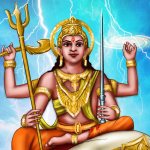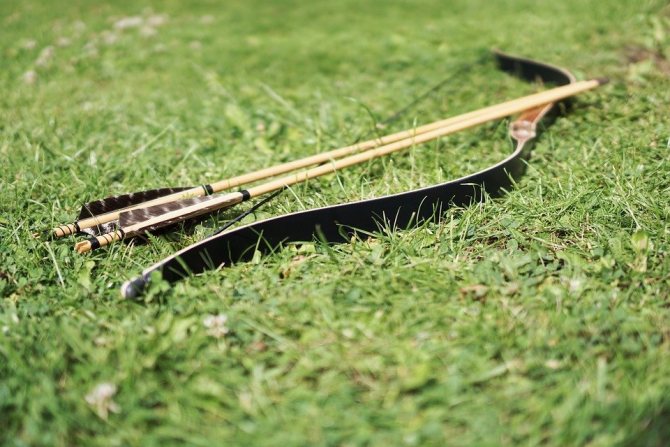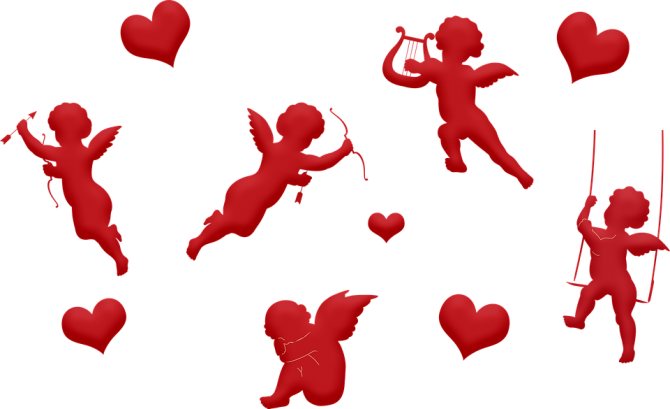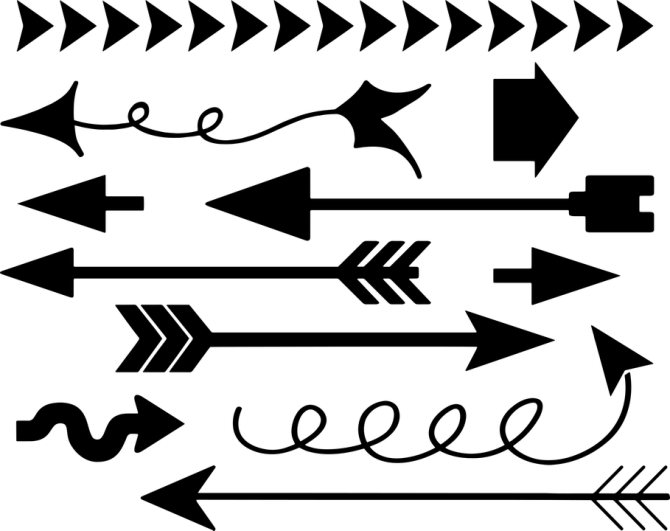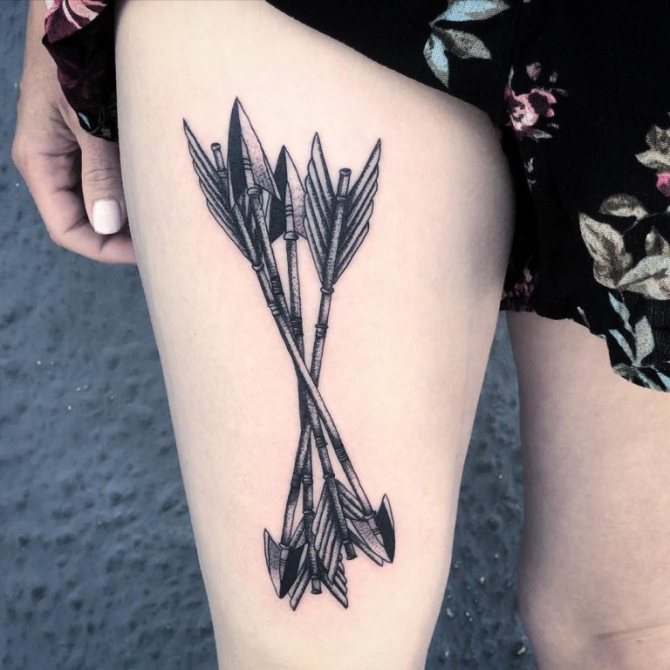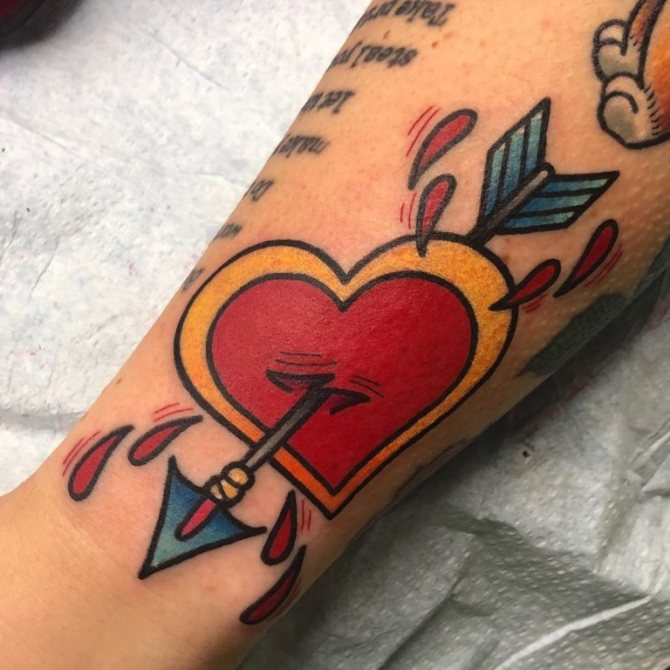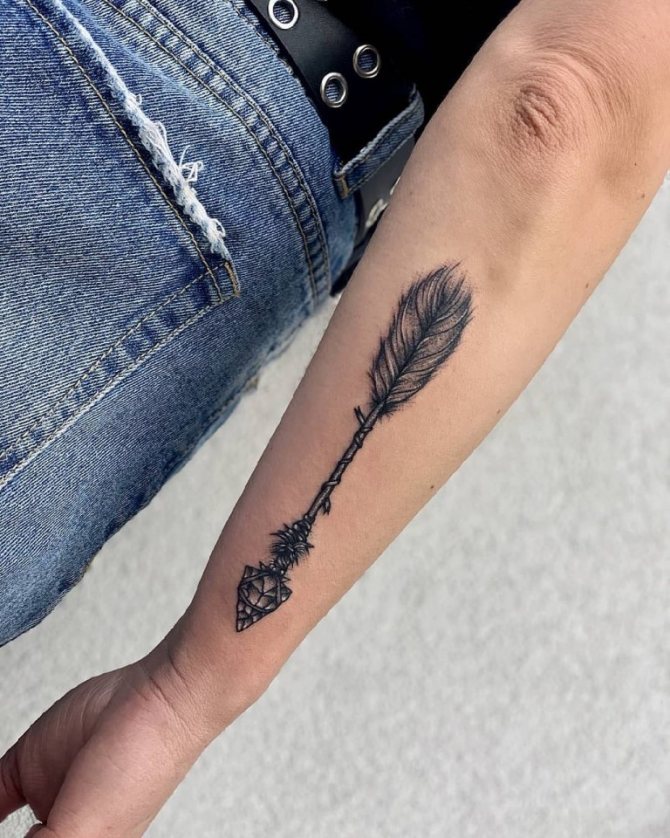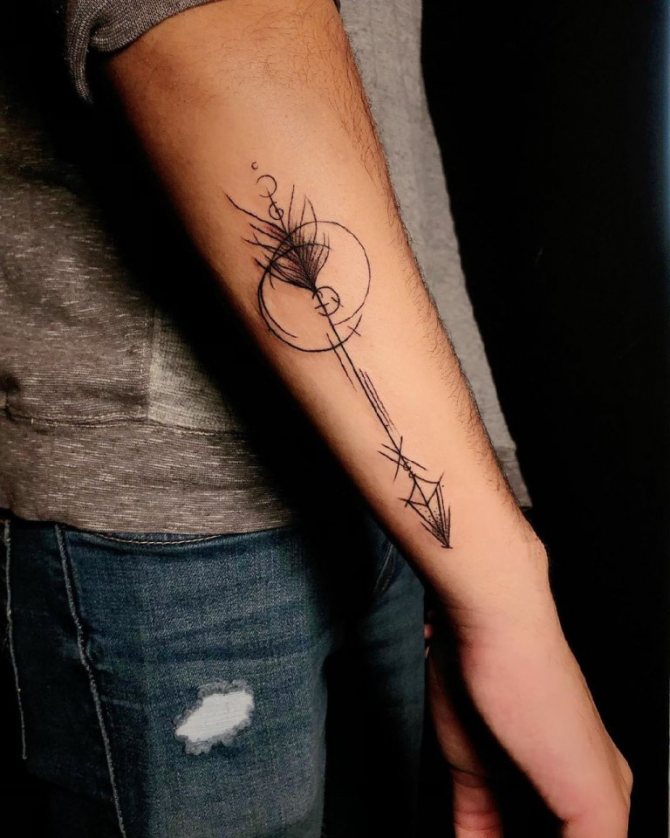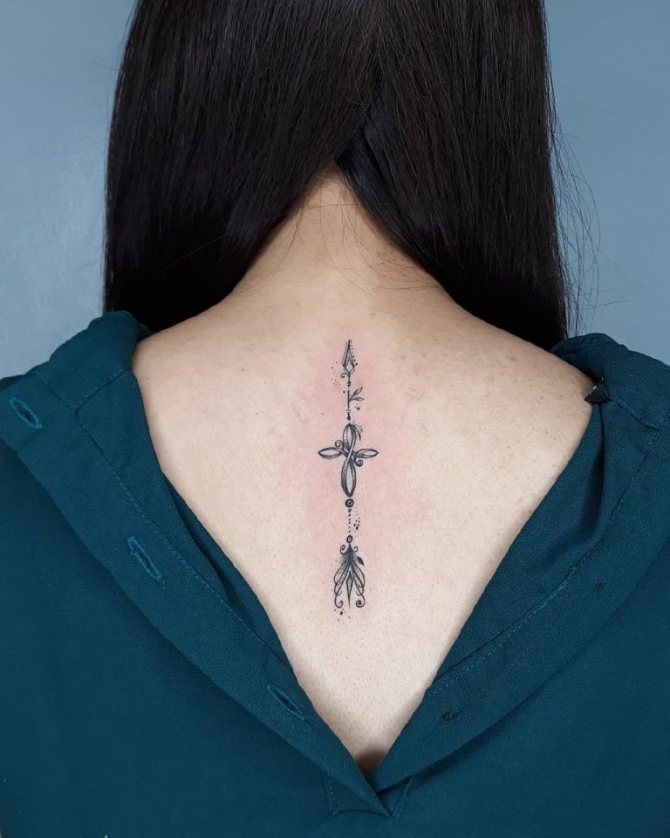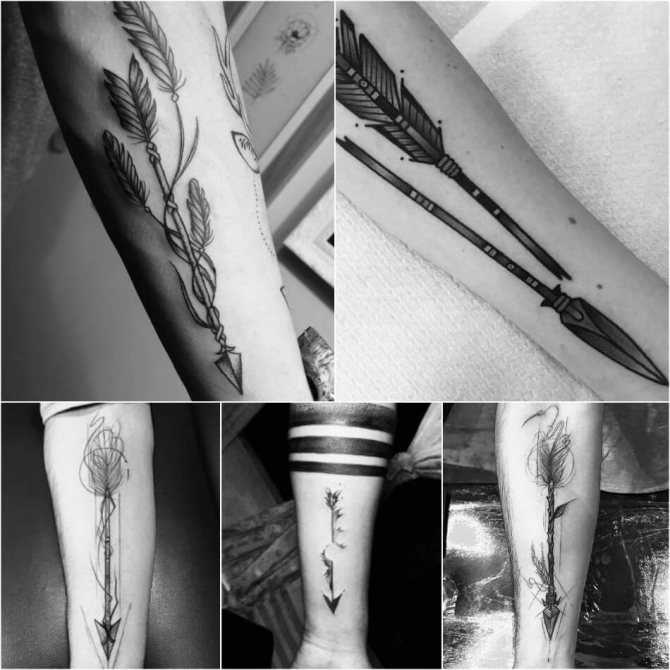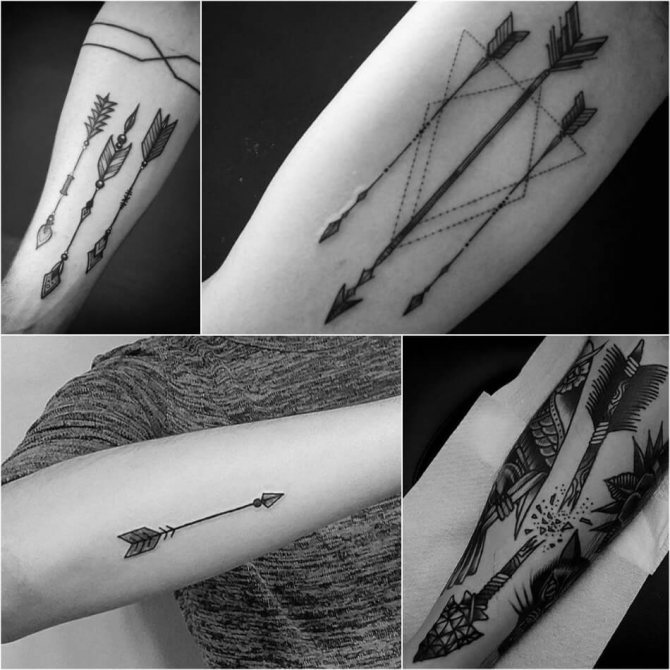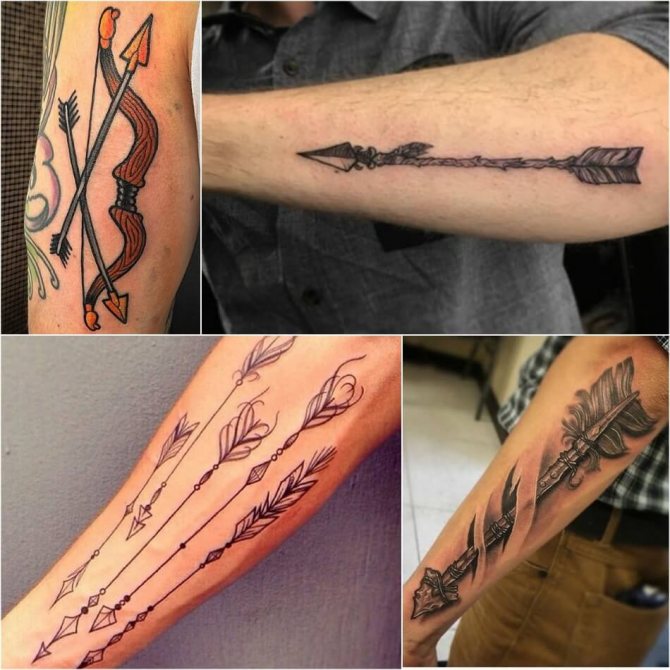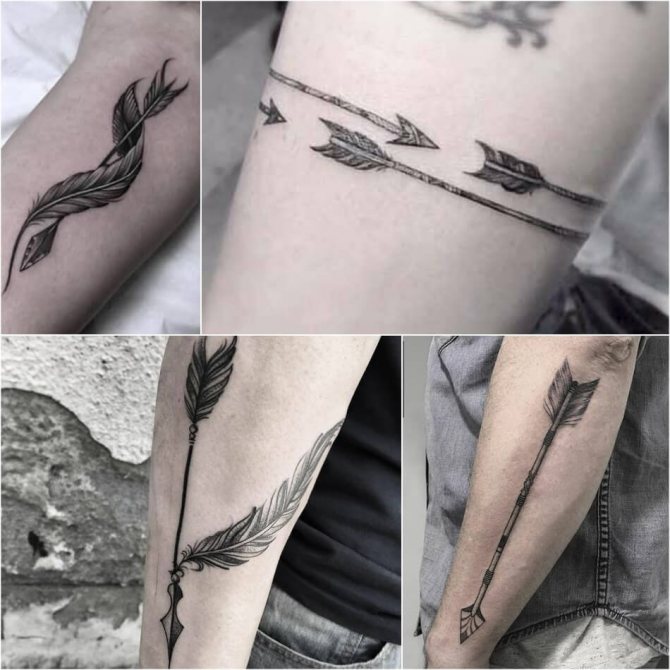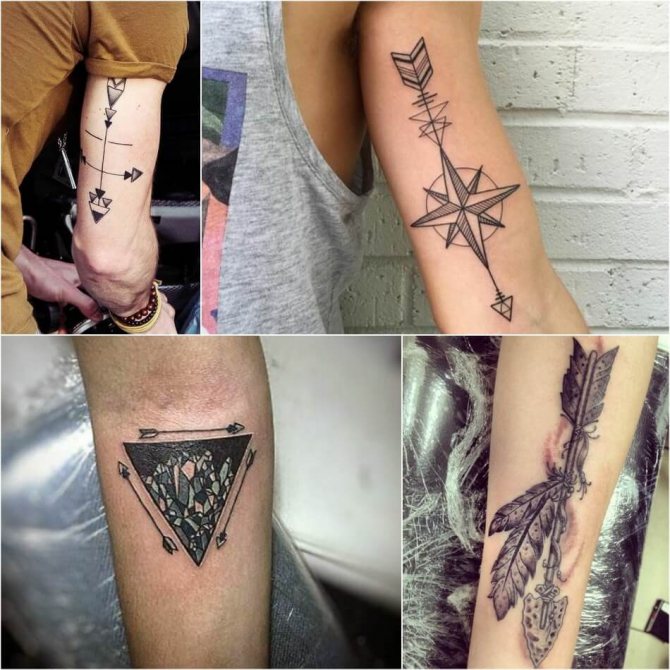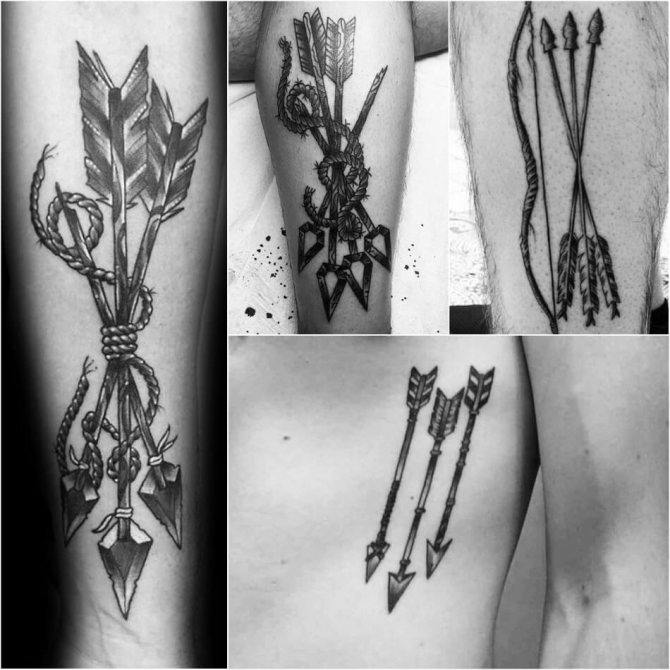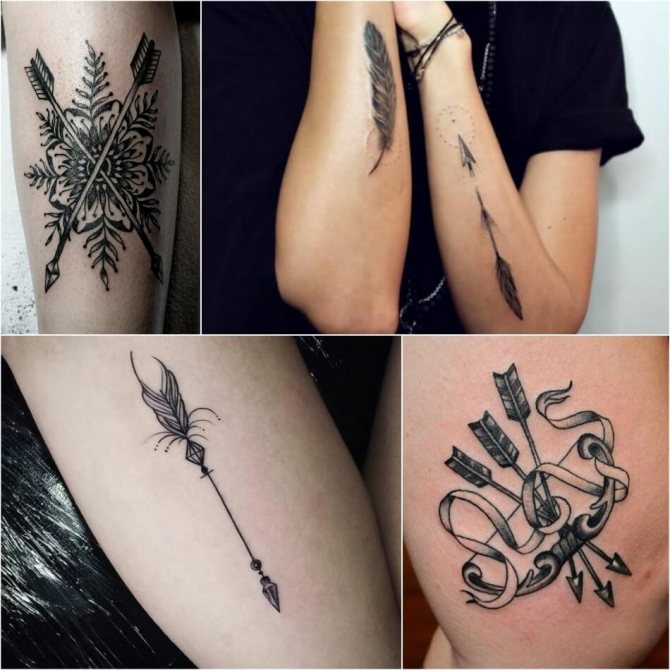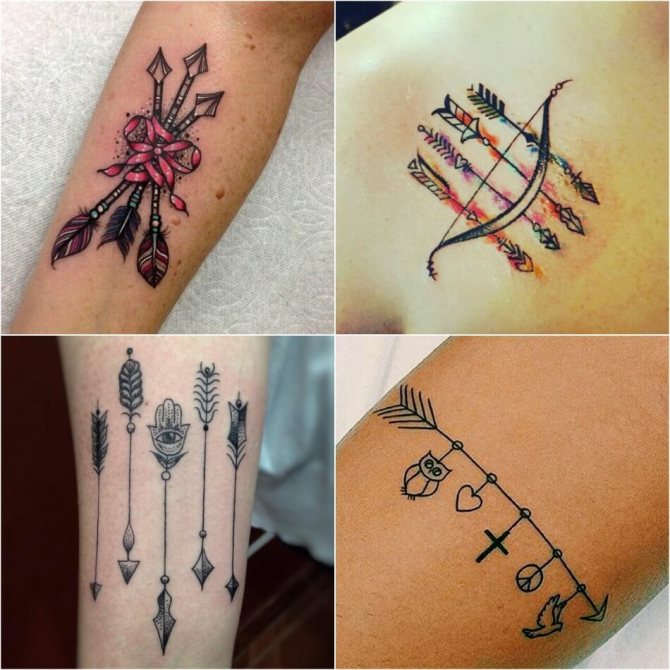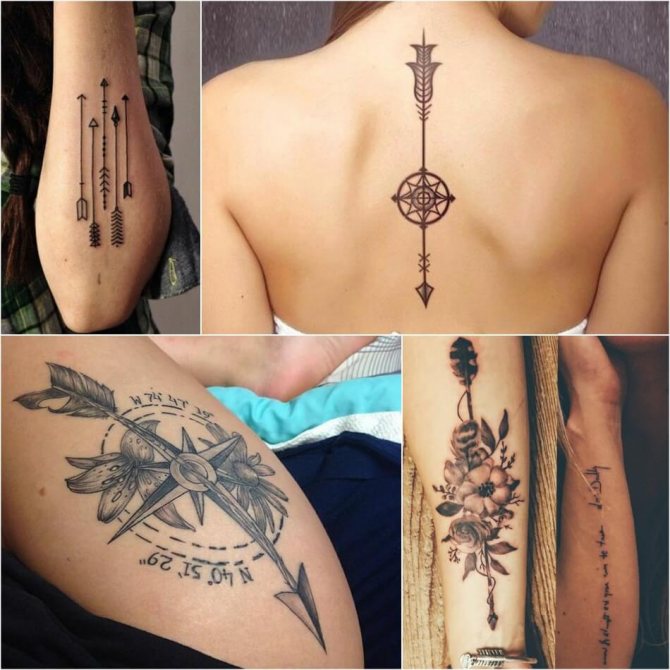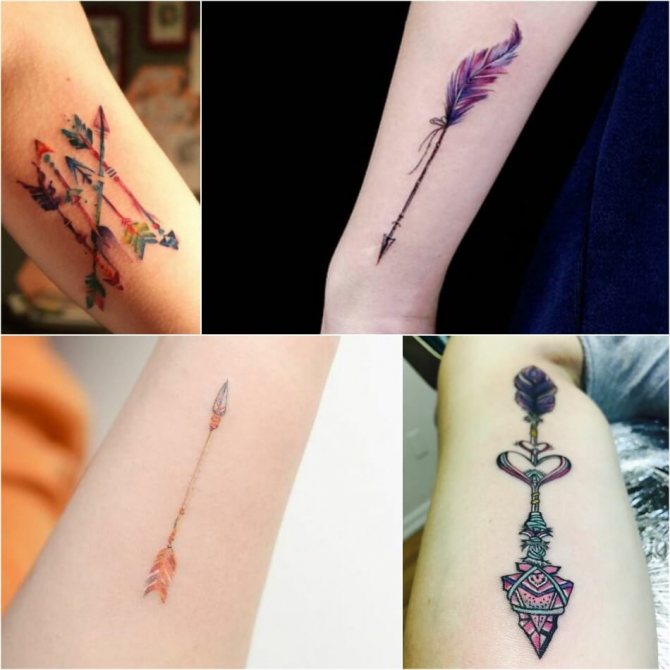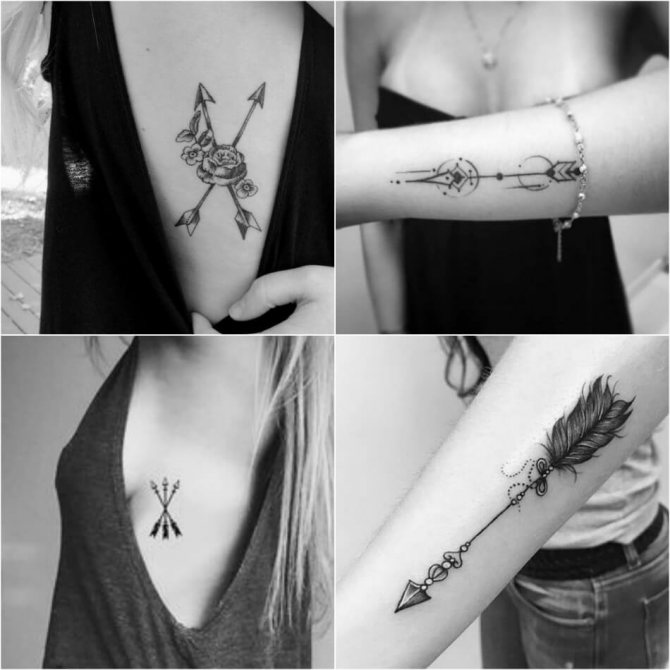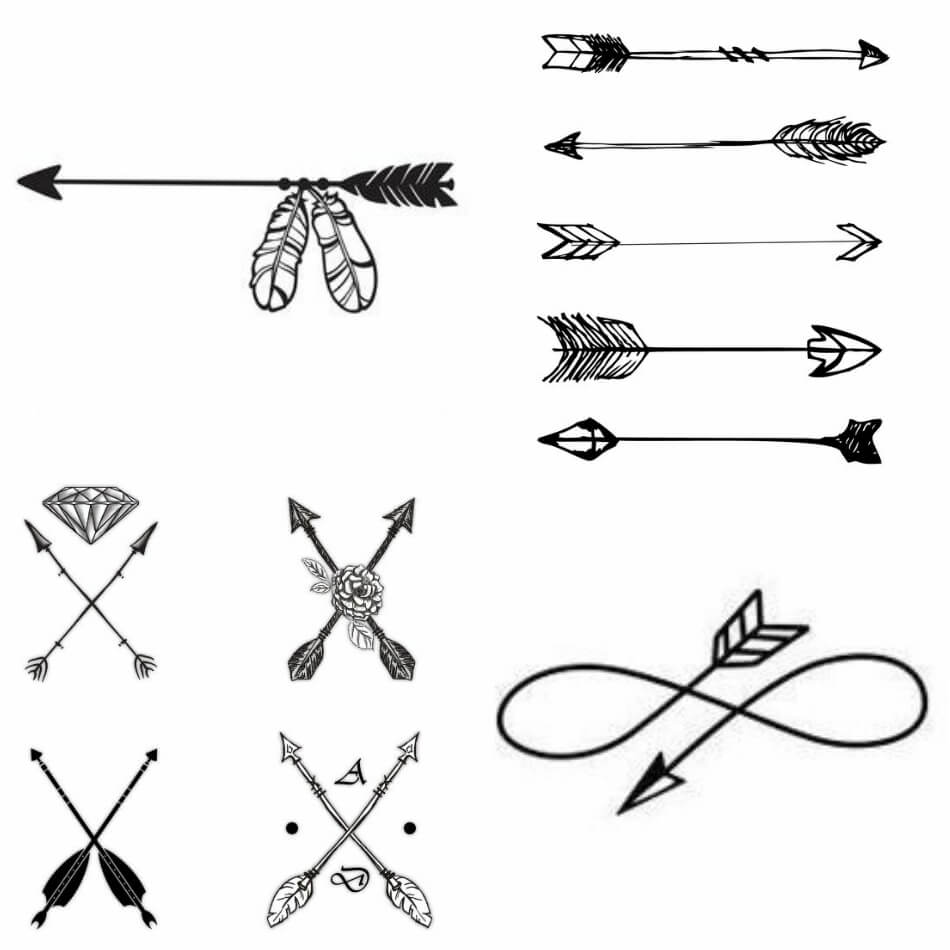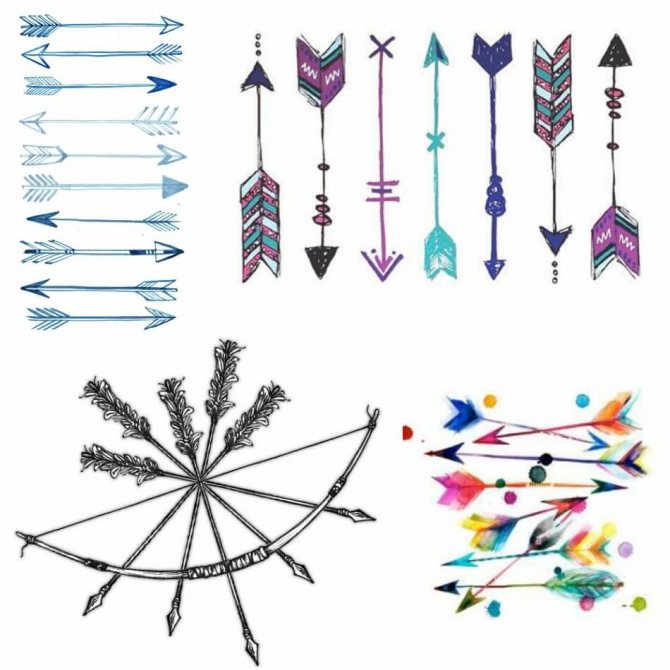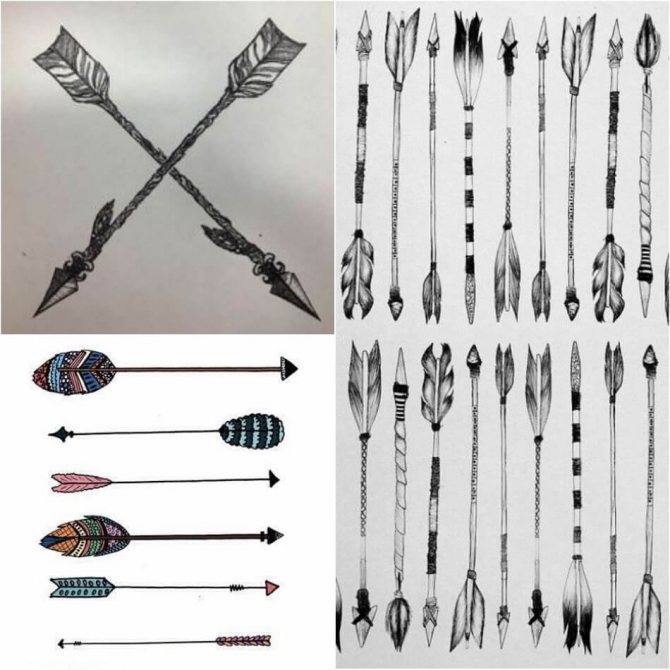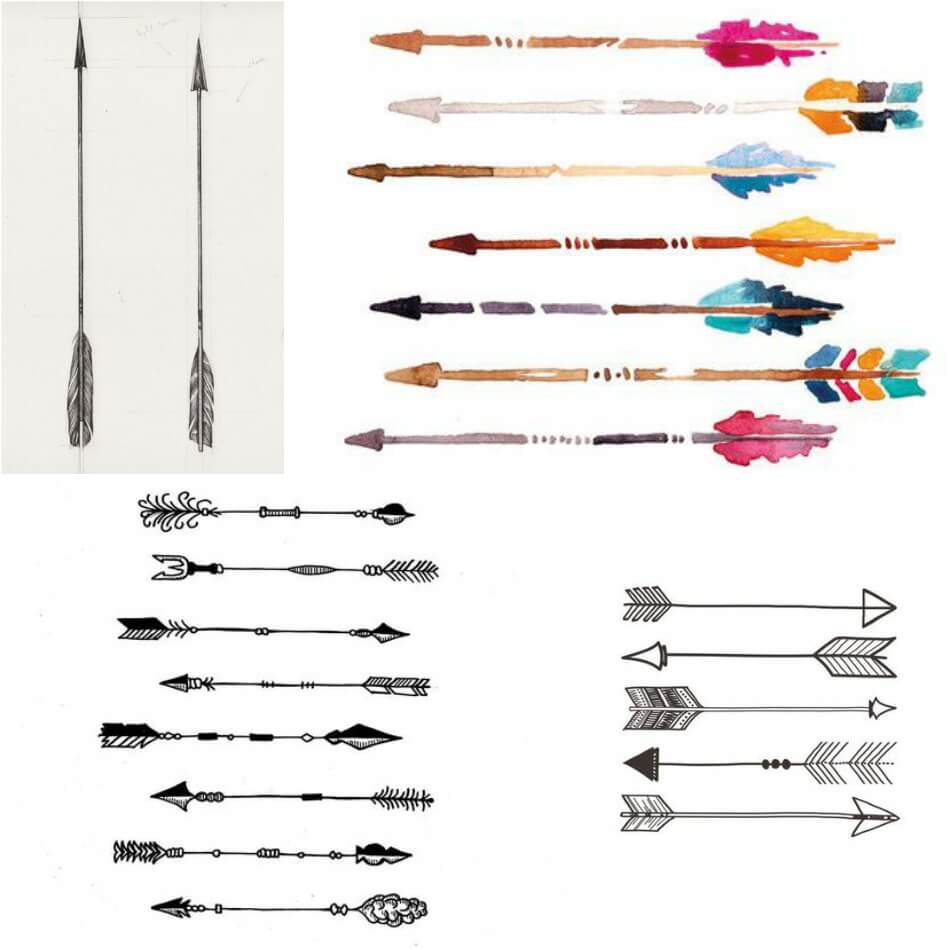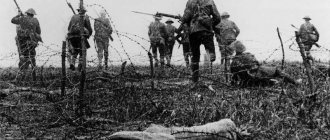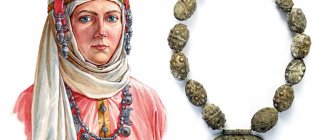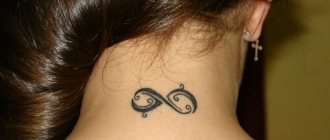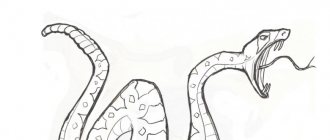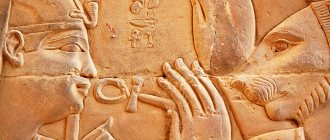The meaning of the arrow tattoo
The first, slightly outdated meaning of the arrow is a symbol of militancy. In the old days, a bow and arrow helped people feed their community. Today, if an arrow is chosen as a symbol of hunting and war, it is in a figurative sense. The arrow in this case means the war for their interests, truth, ideals.
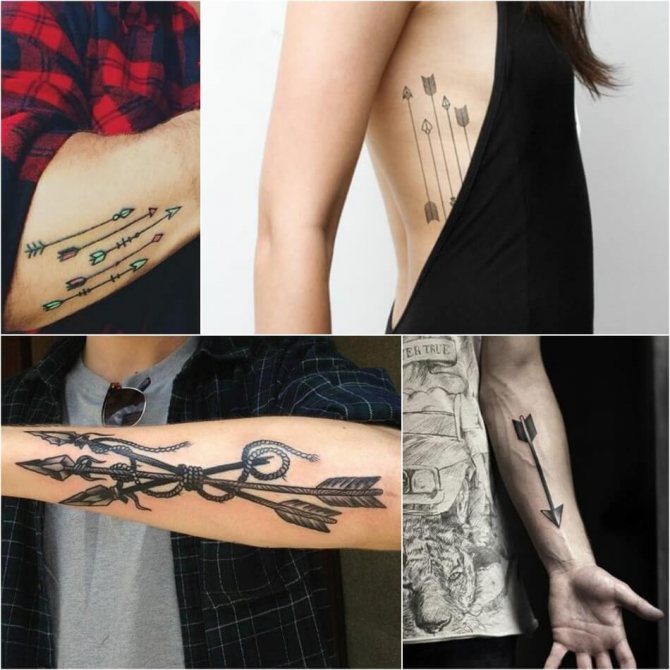
The second meaning of the arrow tattoo is associated with the god Cupid, who struck the hearts of people with love, thus creating couples. Tattoo crossed arrows means the union of two people, the crossing of their lives.
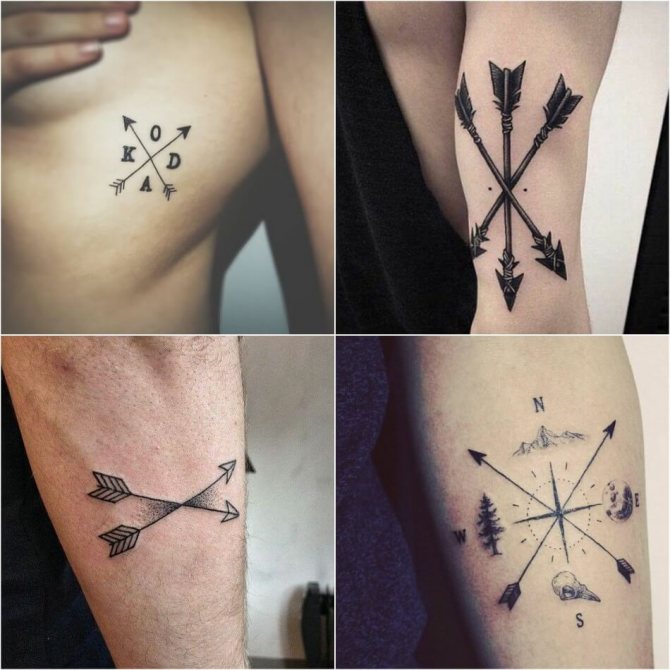

Another meaning of the arrow is the directionality, purposefulness, a clear position in life. The arrow is like the symbol of the sun's ray, which brings to earth the light and warmth necessary for life. So a person who has chosen his path and realized his destiny carries a positive charge to everyone around him.
A tattoo of a bundle of arrows means unity. An old proverb teaches that one arrow is easy to break, but a large number of arrows are strong and resist the interference of others.


Mandorla
One of the symbols symbolizing the feminine, materially manifested universe, which gives birth to all forms of life. This is a very old sign of the Majestic Mother, the Goddess, Devi, which also means womb, womb, space birth, which directly shows the fertility, childbearing, it is one of the forms of yoni (female origin in the Vedic tradition). Mandorla, translated as "amygdala", graphically looks like a space connecting two intersecting circles, symbolizing the birth of life. In the center of the mandorla, we can see a point or another image that signifies the seed of life, the masculine. And in Buddhism and Christianity, the figure of the Buddha or Christ is placed in the mandorla: around them it is like a special form of halo, radiant, signifying the union of the spiritual and the material. When the spiritual, the spirit of life, impregnates the material, the yoni. Mandorla conveys the radiance of divine glory, spiritualizes and makes countless forms of life. This sign, as a talisman, is not bad for pregnant ladies and newlyweds, for successful childbearing.
Popular Arrow Tattoo Places
Tattoo arrow on your arm
The most common place for an arrow tattoo is the arm. The sketch can be placed on the shoulder or forearm. A small drawing with crossed arrows will fit harmoniously on the wrist.


Tattoo arrow on the leg
A favorite place for tattoos among girls is the thigh. Thin arrows, decorated with flowers as in the best way will emphasize the beauty of the curves. Men tend to have arrow tattoos on their shins.
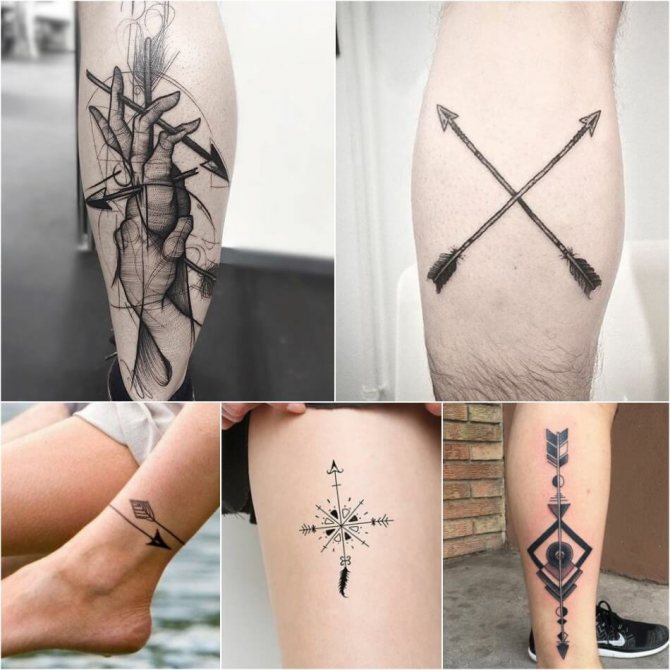

Arrow tattoo for guys
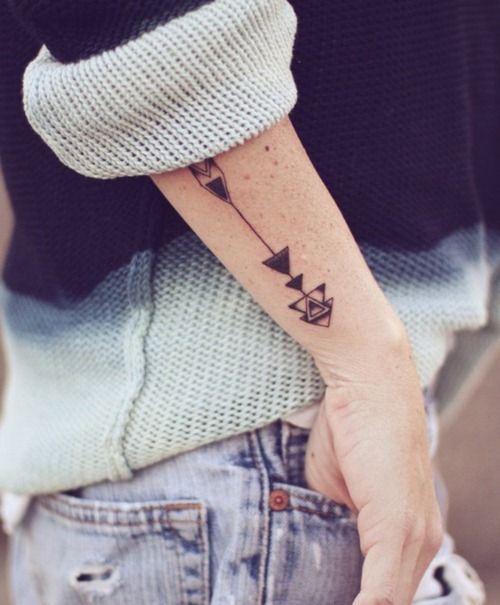

Many people associate the arrow with combat or hunting, so for men this tattoo has a special meaning. They see in this symbol self-control, equanimity, marksmanship, agility and other qualities inherent in hunters and warriors. Male representatives apply the tattoo in black or dark blue colors.
Typically, it is geometric or symmetrical images on the wrists, shoulders or calves. Men prefer to put an arrow without complex elements, but can complement a bow or a defeated beast. You can also find an eagle carrying an arrow in its beak or claws on the body of guys.
Even if, it is an arrow tattoo, it is worth considering that its direction has its own special meaning:
- North - knowledge and experience;
- South - chastity;
- East - farsightedness;
- West - anticipation or intuition.
In the past, men used arrows and bows to get food and reclaim land, so many owners of such a tattoo associate themselves with the extractor and the owner. They are characterized by hardness and equanimity, the ability to go to the goal and win.
Tattoo arrow for men.
Historically, all military and hunting attributes were considered to be exclusively male symbols. But over time, the arrow tattoo has come to mean not a commitment to the military cause, and determination and mental acuity. These qualities are close to many men, and therefore the arrow tattoo is often the subject for the male tattoo.
The arrow is like a sunbeam. From this was born the most ancient mythological story:.
From this was born the most ancient mythological story: a shining hero strikes the swirling dark serpent with an arrow (dart, spear). This is how the sunlight breaks through the clouds, dispelling the darkness on earth.
So Heaven comes down to earth in the flesh of light.
Very interesting information about the arrow as a cult object or an instrument of magic, we find in Iamvlich. In his book "The Life of Pythagoras" he testifies that the wandering philosopher Abaridos the Scythian transmitted to the famous Pythagoras of Samos (VI century BC) a mysterious arrow, which he brought especially for this purpose from the distant coast of the gulf of Venice (now Baltic Sea).
What kind of arrow was it?
Historical science knows that the Scythians (that is, the ancient Russians) were the first people to learn to cast faceted copper tips. (Compare: Western European tribes did not consider the bone tip an anachronism even before the thirteenth century.) But the wanderer did not come to Pythagoras, of course, to boast of his people's achievements in crafts.
According to James, the arrow brought by Abarid possessed supernatural power. By taking it in his hand or by saddling it he could overcome by air such obstacles as wide expanses of water or mountain ranges.
The modern reader will, of course, only smile at such a report. But the skepticism will be due to the superficiality of the judgment. The ancient sages often spoke in symbols. The head of the Syrian order of Neoplatonists, Jambleach, knew this language, of course.
The arrow represented the sign of the highest initiation into the Russian Northern Tradition. We tell about this ancient Tradition in detail in the book "Planetary Myth" (M.: Alva First, 2008). The degree marked with an arrow was called Tietai or Wanderer. It was indicated in the writing of the sacred rune Tiu: b - "arrow". (The name of this rune resonates with the sound of such Russian words as "tetivi" and "tula"[1]).
The presentation of the arrow by Abarid symbolized the initiation of Pythagoras into the Wanderers. Such a degree presupposes the possession of some of the abilities that people usually attribute to the gods. When the initiation took place, Pythagoras' disciples began to call him none other than Apollo of Hyperborea.
The travelling sage, who remained in the history as Abarid and Scythian (so Plato and Hymerias called him in their Eclogues, and also Heraclitus of Pontus), was the representative of the ancient North-Russian zhretses' community. And he was, as it was called in those days, its king-priest. This is why he was nicknamed by the Greeks Abarid (distorted Obodrit), because he belonged to the family of the Bodrites (Obodrites).
From the same sort will occur, almost a millennium and a half later, "Vikings" Rurik[2]. He, as his grandson and only legitimate heir (the others were killed in the fight), was summoned to the reign by Gostomysl in the year 862. And thus earns from the Russians, Krivichi, Slovenes, Chuds, Vesi and other tribes of the Northern Union the honorary nickname Prudent.
" Bertinian annals inform, that Rurik was the Christian and in sacred christening has received a name George [3]. Therefore, honoring Christian belief and the ground Russian, has ascended a throne of the last on September 21, that is on Nativity of the Virgin, the patroness of Russia. Rurik's companion Askold became the first "official" (half a century before Vladimir the Saint) baptizer of the Rus' of Kyiv.
Rurik's spiritual position can be explained by his belonging to the clan of the Bodriches. Magi of the latter kept pure the Northern Tradition, which from time immemorial predicted the coming of the incarnate Son of God. And fidelity to this Tradition was reflected in the heraldry of the highest aristocracy. The Rurikovich coat of arms does not so much resemble a falcon falling on the prey or a trident, as arrowhead
. It is turned downwards, and it marks the way of the sunbeam - the descent from Heaven to Earth.
Arrowheads of the Bronze Age (Museum of Sloboda Ukraine, Kharkov region)
The similarity with the arrowhead is especially noticeable on the coat of arms of such illustrious Rurikovich as Svyatoslav Horobry, who in 965 crushed the Judaic slave-holding Khazaria.
Seal of Svyatoslav Horobny
A Christian cross is depicted right above the coat of arms on this seal. Meanwhile, in modern scientific (and clerical) literature Svyatoslav is commonly portrayed as a rabid pagan.
Of course, Svyatoslav (as well as Equal Apostles Constantine the Great) not only did not prevent the veneration of the gods, but personally honored them. However, this does not mean that Svyatoslav rejected God the Triune Almighty. Here is what the priest Victor Kuznetsov says about Rurikovich: "Grand Duke Svyatoslav, even allowing for the idea that he was not baptized ... still did many of his deeds as a Christian in fact. We can say with certainty that the war he waged with the Khazars was not only patriotic in its direction, but also religious, because it was waged against the anti-Christians - the Khazars ... and (represented) a blow to the Talmudic Judaism. It is possible to tell also, that Grand Duke Svyatoslav ... was on the actions the forerunner of the saint Venerable Gennady of Novgorod and Joseph of Volotsk, which were resisting plague XV-XVI centuries in Russia - heresy Judaizers "[4].
That is how the Russian people remembered Svyatoslav: the Orthodox knight-crusader. Even on T-shirts next to images of him you can see not only a stylized arrowhead, but also a cross. (By the way, under the banner of Svyatoslav fought three hundred orthodox Christian knights, commanded by Svyatoslav's younger brother Uleb[5]).
However, let us return to the arrow that Abaridus gave to Pythagoras half a millennium before the birth of Christ. As we said, it was a dedicatory symbol, and a supreme one at that. The material object which is chosen as such is not accidental. It is as if it were the embodiment of that idea, that wisdom in which initiation is made. What was the sacred message embodied by the arrow?
The inviolable rule of the mysteries is that their sacred objects do not have only one meaning, but levels of meanings.
The level is obvious and superficial: as soon as initiation into the Wanderers, the symbol is the arrow, the ideal wanderer. It freely reaches "from point A and to point B" practically in a straight line, or rather in an inclined arc. There are almost no obstacles that could interrupt the journey.
But there is a deeper level. It is about spiritual wandering, about the search for the Free Will. The arrow is free to fly, but it finds it only because its aspiration is obedient to the will of the one who sent it. But this sender is worthy to rule only because his will coincides with the dictates of Heaven, to which he is obedient. The princes in the Russian fairy tale meekly take as a wife the one near whom the arrow they shoot falls. Freedom is achieved neither by rebellion nor by rejection at the price of servile obedience. Freedom is attained only by a free and unrestricted trust in their Creator in all things, as little children without compulsion forcefully and joyfully do the will of their parents. Synarchy, that is, the symphony of godly wills on different levels, pervades the universe like a ray of supreme light or a heavenly arrow.
But there is a deeper level to this symbol. The arrow of the Hyperborean Mysteries stood for Prophecy. Probably the oldest on earth. It pierces history like an arrow sent flying through time. From the era of the legendary Arctida to the Day of its fulfillment. More about this is told in our books "Hyperborean Faith of the Russians" (M.: Fair-Press, 1999) and "Evangelic Magi from the East
Essence of the Russians" (M.: Alva First 2009).
It is the prediction of the Perfect Wanderer. About the Son of God, Dazhdbog, who will descend to earth as a result of the conception not according to the flesh and will return without leaving the flesh (i.e. having defeated death) - Home. The delivery of the arrow signified the knowledge not only of the coming of the Perfect Wanderer, but also of the Name that He was destined to bear on earth. This will be discussed in detail below.
It is possible that in presenting the arrow to Pythagoras the combination of words was heard for the first time on earth. The Greek "christos" means "the great initiate. "Isa" means "arrow" in the Proto-language, as will be discussed below. Jesus Christ is thus the Dedicated of the Arrow, and the capital lettering marks the greatest of all such initiates who ever were, are, and will be.
As we noted above, the arrowhead depicted on the seal of Sviatoslav the Good is stylized. Namely, it represents the ancient rune of Dazhdbog turned by 180°:. (In the system of modern Russian writing, called "Cyrillic alphabet"[6] it became the letter "D") The arrow pointing downwards represented the sign of Perun. Therefore Ivanchenko is right when he says that the "two-tongue" of Svyatoslav the Good is simultaneously a sign of Perun and Dazhdbog. [7] It is easy to see that the so-called "trident" of Vladimir Sviatoslavich are, in fact, inverted sign "D" and arrow. Runa Dazhdbog, arrow and cross finally merge into Trident only on the srebreniks of Yaroslav the Wise).
The prophecy of the coming of the incarnate Son of God, to be born of the Virgin, was retold after the "Scythians" by the initiates of almost all nations. (Even the Old Testament contains vague echoes of it.) One of the oldest and most accurate reproductions of it is the Bhavishya Purana of the Hindus.
The title of this treatise translates as "Bylinae of that which is destined to happen." It was written by the sage Vyasudeva at least three millennia before the birth of Christ. It reads: The Son of God (Isa Putra) will come from a virgin, who, having conceived Him and given birth to Him, will remain virgin (Ku-Mari Garbha Sambhava). This is destined to take place in a faraway land. The wicked people of this land will give up the Son of God to a painful and terrible execution. But He will rise again.
The word for "arrow" in Sanskrit, that is, in the language in which the Bhavishya Purana is written, sounds like "isu". Novikov-Novgorodsky says in his book[8] that the name of our Lord JESUS may have come from the Sanskrit arrow.
This is a very interesting idea that deserves the most careful attention. Especially when you consider that Sanskrit is nothing but a derivative of the Northern Russian dialect. Because the world famous Sanskritologist Durga Prasad Shastri, travelling in the second half of the last century in the North-Russian hinterland, discovered to his surprise that when talking to the locals he did not need an interpreter.
!
Durga identified the North Russian dialect of the remote villages as as an ancient form of Sanskrit.
. He made a sensational report about it at a conference in Gazibad in 1964. And yet Sanskrit was considered the most ancient of all known languages of mankind.
What explanation can be given to the fact discovered by the Sanskritologist? Runes of the Book of Vela recorded the story of the march on Hindustan ancient Russians, which occurred around the eighth millennium BC. Their leader was prince Jaruna. And he was the founder in India of the dynasty of the Pandavas, that is, the white-skinned ones, which is still considered to be the most ancient aristocracy there.
Could the name taken by the peoples of Palestine as "Jesus" come from the Sanskrit (or rather, proto-Sanskrit, that is, Old Russian) "Isu"?
In Luke's Gospel we read: "The angel said to her, 'Do not be afraid, Mary, for you have found grace with God; and behold, you will conceive in the womb and bear a Son, and you will call His name Jesus. He will be great and will be called the Son of the Most High...and his kingdom will have no end" (Luke 1:28-33).
Could Luke have actually said, "And you shall call His name Jesus"? And afterwards, as a result of numerous rewrites, reinterpretations, and translations, could it have become "Jesus"?
Luke is the only one of the four canonical Evangelists to speak of the Annunciation. Church tradition tells us that this evangelist was "of the Gentiles" and that before he came to Christ he had "the wisdom of the Magi": he healed diseases with herbs, played the psaltery and the flute, and could paint on boards with paints. Luke was the first Christian iconographer. He painted the image of Our Lady of Vladimir, whom he had seen in his earthly life and imprinted Her face, according to Church tradition, on the same tabletop at which the Holy Family ate.
Luke is a "Scythian" name. The full form of his name is Lukoslav. And its interpretation is as follows: glorious by archery. (This martial art was considered by the kshatriyas and brahmans of India "royal", a reference to it often served as an allegory of initiation). Church tradition has preserved information about another Lucaslav, who was a contemporary of the Evangelist and "a man of the apostles. "The Sermon on the Mount says: Lukoslav, Silas, and Phirs, who were baptized by the Apostle Andrew, went with him through the lands of the "Scythians, Skothians, Skophans, and Slovenes," "baptizing everywhere and placing crosses of stone in the places."
By the angel of the Annunciation, which Luke confesses, is meant Gabriel. As a rule, he is depicted appearing to the Virgin in a shining ray of the sun. Vedic Orthodox Tradition sees in this luminous archangel the fire god Semargl, the patron of the constellation of Sagittarius (Kitovras). The ancient prophetic legend represents Semargl as a messenger sent to the Maiden by Svarog of Heaven to foretell the birth of Dazhdbog.
The "Scythian", i.e. Old Russian, myth speaks of the conception of Dazhdbog not according to the flesh. For this he uses the symbol of the Arrow of Heaven. It strikes the stone near which the Virgin stands. An image transpires on the stone. At the Virgin's word to Svarog this image is made into living flesh. Therefore, the stone of Dazhdbog is considered belemnite, resembling an arrowhead, and His symbol is an arrow.
All of the foregoing demonstrates that Luke the evangelist could have inscribed "Isa. But it does not yet prove that he actually did.
What can serve as proof that the Son of God during His earthly life was really called "Isa", and only in later centuries this name was transformed into the popular name "Jesus" in Palestine? Such evidence would be the facts of the original name preserved elsewhere.
The Muslims' way of referring to Christ as "Prophet Isa" is not uninteresting in this sense. Their faith was founded five centuries after His earthly life. At that time the real name of Christ might well have been remembered. Moreover, the name Isa, if it was found in the Qur'an, had every chance of remaining unchanged there. After all, Muslims revere Christ as just one of the prophets, not the founder of their faith, so the malicious scribes simply wouldn't waste time in twisting this name.
To this they might say: In the Koran we simply see the Arabic version of the name "Jesus", which in Hebrew is written as "Jehoshua". It is the Arabs, de, who have transcribed it incorrectly from the Hebrew. The proof that "Esu" and "Jehoshua" are different names, and not variants of the same name, can only come from a document that mentions them as, precisely, different names.
Why the Arabs would rewrite from the Jews is unclear. But we will not go into this question, but simply state the fact: there is a document where the two names are mentioned as clearly different. This is the Jewish tractate Sanhedrin, in which it is written, for example: "Yehoshua ben Perakhya, who repelled Yeshu ha-Notzri with both hands" (107b). Also, elsewhere in the Sanhedrin, any rabbi or Jew named Yeshua (Yehoshua) is called by that name and nothing else, while Christ is referred to exclusively as Isa (Yeshu). Consequently, we are faced with two different names.
The latter is so uncharacteristic of Jewish texts that historians have wondered: where did it come from in the first place? And they suggested that it was some derogatory nickname invented by the creators of the Sanhedrin exclusively for Christ (but they could not say anything about the meaning of this nickname).
The assumption, however, was not unreasonable. After all, the Sanhedrin contains a host of derogatory and slanderous fabrications about Christ. The rabbis of the early centuries shamelessly concocted them in order to turn the Jews away from Christian preaching by any means necessary.
But in this case, the Pharisees did not even have to make it up. After all, the foreign name "Isa" for them could not be better combined with the definition of ha-Notzri-that is, stranger, foreigner-which they always wrote beside it.
The fact that Christ was just that to them, that is, not a Jew, is also stated in the Gospel (Jn 8:48). And if any Jew tried to take the side of Christ, the rabbis reminded him at once that He came from another nation, and that "this people, being ignorant of the law (of the Jews), is accursed" (Jn 7:49). The Jewish law, on the other hand, commanded that a foreigner not only not be seen as God, but even as a mere human being (Deuteronomy 7:2-6).
It was only many centuries later, when Christianity became not only the world religion, but one of the most influential in the world, that Jewish leaders of the Diaspora took hold of the exact opposite thesis. Namely, they began to convince the kings of Europe that "your God is our kinsman. This may have been the first time in history that information weapons (or rather, disinformation weapons) were used en masse. And then, apparently, the rabbis began to pronounce "Yeshua ha-Notzri" instead of "Isa ha-Notzri," although the latter was nonsense.
Thus, the Son of God bore the name Arrow during his earthly life. It was unfamiliar to the Jews, but it spoke much to the Scythians, Hellenes, and Romans.
We spoke above of the dedicatory symbolism of the Scythian school.
The Hellenes perceived the arrow as a sign of Apollo the Hyperborean, as a symbol of the Elysian Mysteries derived from the temple in Delphi, founded in the 7th century BC by the wandering philosopher Scythian Olenus. [9]
The Romans understood the arrow as the sign of Mithras, whose cycle of myths echoed the Scythian tales of Kolaksai, that is, of Dazhdbog.
The very name of Christ served, as we see, the peoples to understand the spiritual roots of the doctrine expounded in his sermons.
Is there any more evidence that the Son of God bore the name Arrow during His earthly life? Yes, and moreover, it can also be found in the writings of those who hated Him.
The same Sanhedrin and other rabbinic treatises refer to Christ as "ben Stada. What does this appellation mean? Again, no Jewish writings mention anything like the word "herd," except when referring to Christ. No intelligible explanation is given for it. Some of the rabbis mockingly remark, however, that unless the sound of the name resembles the pronunciation of the words "she has changed" and therefore the expression "ben Stada" means "son of She has changed", that is, "the fruit of sin".
The early rabbis loved to spread this kind of gossip. That is why Christ is also called in their texts "ben Pardus," that is, "son of the Panther." Allegedly, Mary cheated on Joseph with a Roman centurion, a Scythian, who had such a beast depicted in gold on his shield. In fact, the famous golden panther of Scythian shields is the image of a lynx. It is the totem animal of the ancient Russians, but this inhabitant of the northern forests the peoples of Palestine did not know, of course, and therefore took his image for a panther or a leopard. After almost a millennium BC Khazars, who were defeated by Svyatoslav, called him Prince Pars, that is Bars, because they saw the image of the same golden lynx on the shields of his soldiers.
What can actually be the meaning of this word "Stada"? It resembles a distorted "stagida" or "sagitta", i.e. "arrow". Could there have been such a distortion of the Latin sagitta among the Palestinian peoples at the time of Christ? Very likely. For even up to our time the word "stadia" (obviously derived from "flock") has survived, which originally meant the distance of an arrow's flight. This was the measure of length used by most Palestinian peoples. Its value varied with them from about 170 to 230 meters - accordingly the range of the national bows.
So the "son of the arrow" is a direct copy of the Scythian myth in which to depict the conception of the Son of God not according to the human flesh the symbol of the heavenly arrow which struck the stone next to where the Virgin stood was used.
However, it could not be that the evidence only "from the contrary" (in the sense of - from the opponents) survived. This is why it is important to ask: did early Christians know their God as the Arrow?
An early Christian marble tomb in the catacombs of Rome depicts Christ holding the Heavenly Arrow and a Scythian swastika, the symbol of the Sun.
The silhouette of a fish and an anchor are usually considered to be early Christian symbols. However, both of them are most likely a later stylization of the earlier signs. After all, the silhouette of the fish almost perfectly repeats the outline of the tip of a Roman arrow. The "anchor" on the images from, for example, the catacombs of Priscilla is much more reminiscent of a loaded arrow crossbow[10]. Next to it is the World Tree with three branches, which is a classic symbol of Northern Vedism.
Perhaps the most striking example of Orthodox Christianity's precise preservation of the sacred symbolism of the Vedic antiquity of the North is the bishop's staff and, in particular, the patriarchal staff. It had exactly the shape of an arrow or Tiu rune, the symbol of the highest initiation into the Northern Tradition, as was mentioned at the beginning of this work. The ecclesiastical tradition says that the staff of the pastor went from the apostolic staff and, therefore, it must have retained its form.
On the fresco of the Vladimir cathedral in Kiev (V.M. The top of the patriarchal staff is very clearly visible in a 19th-century Vasnetsov photograph of the baptism of Prince Vladimir, with the wings of its handle dropped down at a 45° angle, which gives it the characteristic shape of an arrow.
Such staffs went out of use in Byzantium only after it signed the union with Catholicism. In Russia they also disappeared much later - after the Nikon reform (which is now often referred to as the Nikonian heresy
). The wings of the tip lost their former arrow-like shape, as if bent upwards and turned into two serpents, the heads turned to each other.
However, there was a reminder that originally the form of the bishop's staff was arrow-shaped: sulok
. This is a special cloth - a piece of cloth - with which the priest protects his hand, which carries the rod, from frost during a winter procession. The very name of the cloth, canonically still attached to the rod, testifies, that in former times the form of the latter was
sulica-shaped
i.e. arrow-shaped.
The Old Believers stubbornly opposed the "crooked" staff precisely because this innovation interrupted the ancient northern tradition of passing on the arrow as a sign of higher spiritual initiation.
They had an equally profound reason for opposing the Nikonian addition of another "i" to the name of the Son of God. For by doing so, it became more like the Hebrew "Yeshua," which He never bore, than the "Isa," the arrow.
So it was not for some "minor ceremonial discrepancies" that the righteous man Avvakum and his cohorts were martyred by fire in 1682. They sought to keep Russia and all of humanity from one of the most grandiose errors in its history.
The Old Believers and up to this time keep the customs that go back to the time of reverence for the arrow as a sacred symbol. According to their canons, for example, the cross over the grave must be set up necessarily "with a lid," that is, with an arrow-shaped top. It not only represents the protection of the main part of the cross from rain. It, combined with its vertical line, forms the sign of Tiu. A symbol of the direct ascent of the soul of the deceased to the Father in Heaven. That is, passing or reducing the time of "aerial asylum". Old Believers cross appears, therefore, as if inscribed in the arrow.
Note that in ancient times the arrow was also understood as a symbol of "straightness", i.e. righteousness - the absence of all wrongdoing. An arrow thrown with a bow must be perfectly straight, otherwise the accuracy and range of the shot would leave much to be desired. To achieve perfect straightness, a branch cut down on the shaft of an arrow was steamed and left to dry inside a hollow bone. But arrows made in this way were deformed in a few years. For decades, only arrows for decades, only the arrows that were tempered
. They were made by gluing along four splinters with different directions of fibers. It is symbolic that the ideal technique of making arrows required exactly this number of sticks. After all, this is the number of sticks needed to put together the image of the eight-pointed cross. And in this sense, each Russian combat arrow in itself carried the sign of the Orthodox faith.
Yuri Mirolyubov, to whom mankind owes a wide acquaintance with the texts of the Book of Velez, describes in his book "The Sacred of Russia" a pious custom which the Old Believers held in his native land. At Easter and Ascension, an arrow - a sign of Tiu - was painted with soot from a church candle on the whitewashed ceiling of the main room of the house. He represented in this case a reminder of the all-presence of God, a protection against excessive devotion to only earthly cares.
Does it follow from all of the above that Christians should now pronounce "Isa" instead of the name "Jesus"? No, the author is far from preaching anything like that. After all, that would only lead to another "argument about words. It is no secret that names are "formed historically," that is, they are transformed over time. In the course of centuries and millennia, the language as a whole changes, and it is better to speak in the language of our contemporaries rather than our ancestors, so that one understands what you want to say at all.
But it's important to understand the essence. To remember the roots. Under the impression of inevitably changing names and titles, don't forget how and where what actually came from.
This sort of thing is especially important for spiritual concepts. Otherwise one risks either misunderstanding one's own faith or being unreasonably disappointed in it.
For example, it is very important for a Christian to have an understanding of real - not formally attributed to Christianity - sacred history. That is, the pre-Christian roots of the teachings of Jesus Christ. This is especially necessary for the Russian Orthodox Christian today.
Now there are already books that contain information to overcome humanity's greatest misconception in the history of religion.
The book "Christ was not a Jew" (Moscow: Encyclopedia of Russian Civilization, 2004) by the American Consul in Russia, Jacob Conner, has recently been translated into Russian.
About what tells the inscriptions of the Old Russian runami on the religious objects of Vedism, as well as the early and Old Believers Christianity tells the book of Professor Valery Chudinov "Secret inscriptions on Russian icons" (Moscow: Alva-Pervaya, 2008).
The title of the book by Mikhail Novikov-Novgorodtsev, "Vedic Worldview of the Proto-Slavs - the Basis of the True Russian Statehood and Geopolitics" (St. Petersburg: Publishing house of the Union of Descendants of the Russian Nobility named after Tsesarevich Alexei Alexeev) speaks for itself. Tsesarevich Alexei, 2007).
Finally, all of my books in the Palinodia, or the End of the Delusion of Christ series, published by Alva First, serve the same purpose.
November 2008
Table of Contents
The Arrow Tattoo for Women
Girls often give preference to bright boho arrow designs. These are not arrows of war, they are symbols of the divine rays of the sun, clarity of mind and breaking out of the boundaries of ordinariness.
The names of the god Indra.
Aditi performed tapasya for a hundred years according to the reckoning of the gods. Then a son was born to her; he had four arms and shone with the dazzling brilliance of millions of suns. He had many names, including: Indra, Shakra, Pakshasana, Maghava, Vidyuja, Marutwana, Akhandala, Vasuda, Vasudatta
"Padma Purana."
Indra has many names, epithets describing his basic qualities. In particular:
Shakra - Mighty, strong; Vajrapani, Vajrin - Possessor of the vajra, wearer of the vajra; Mahendra - the great Indra; Vesava - the lord of the good; Meghavahana - seated on the clouds; Maghava - generous; Devapati - lord of the devas; Devraj - king of the gods; Devanam Indra. - Lord of the thirty-three gods; Vritrahan - the conqueror of Vritra; Balakhan - the victor of Bala; Sahasraksha - Thousandth; Purandara - destroyer of strongholds; Svargapati - lord of Swarga; Jishnu - leader of the heavenly host; Purandara - destroyer of (enemy) cities; Thunderer - holder of the thunder arrow; Parjanya - rain, thundercloud; Puruhuta - called by many; Shata-kratu - the lord of a thousand sacrifices; The thousand-eyed consort of Shachi.; Amita-kratu - immeasurable.
Also in the Rigveda (I.100.12) he is referred to as "a master with a thousand plots, possessing a hundred tricks", "possessing a hundred supports" (I.102.6) or "unshakable as a mountain, possessing a thousand reinforcements" (I.52.2).
Indra's Weapon
In the Vedic scriptures one can find references to various kinds of weapons which accompany Indra in battles. So, in the Skanda Purana we find the following names of the weapons which Indra uses in battles with the asuras: Twashtra, Agneya and Vaiavya; also the weapons possessing mystical powers of transformation are used: Narasimha and Garuda weapons, Narayana weapons.


...Shakra produced the weapons of Twashtra. When these weapons were tucked into a bow, fiery sparks flew from them, and thousands of mechanical creatures emerged from it. The battle continued with these machines in the heavens. The firmament of heaven was stripped of its stars. "..." The universe was filled with torrents of rain... Seeing that Agney's weapons were repulsed, Indra launched the incomparable weapons of Vaiavya, and by his power the clouds were dispersed, the sky brightened and became like the petal of a blue lotus. "..." Shakra, who defeats (enemies) in battle, released Garuda's weapon. Following that, thousands of Garudas flowed out of him. "..." O Lord, remember the weapon belonging to Narayana, possessor of great purity of mind. Hearing this, he released Narayana's aster
"Skanda Purana," chapter 21
The use of some weapons, are accompanied by mantras, such as:
The Vritra assassin released Narasimha's irresistible weapon. Thousands of lions followed, thanks to the power of the mantra. They had claws like saws. "..." Then he took an arrow with a sharply sharpened tip, which is revered in battle and destructive to enemies. The wise Indra put it in his invisible bow and released it with the Aghora mantra. He drew the bowstring, whose beams were reliable, all the way to his ear, and quickly delivered it to the enemy he was killing. "..." Then an arrow with a sharply sharpened tip, fired as the battle progressed from Purandara's bow with the mantra, like the noonday sun pierced the body of the asur Jambha
"The Skanda Purana, Chapter 21
The Mahabharata mentions the strongest weapon called Indra's flame, "majestic and spewing tongues of flame," "swiftly piercing space filled with lightning," "bright flame illuminating all around. Also used in battles is Vasava's dart, Indra's thunder arrow, an octagonal arrow rich in diamonds, gems and pearls, a highly revered mace.
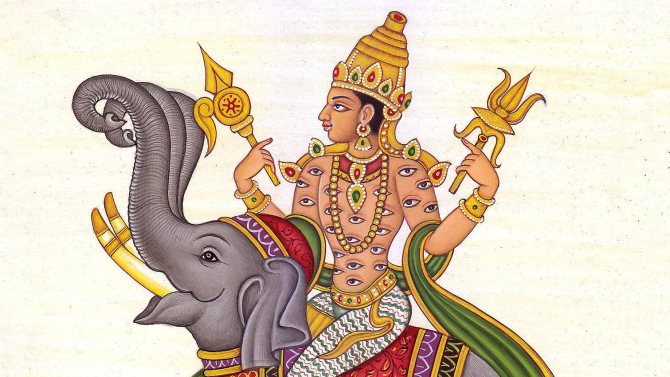

Indradhanus, Indra's bow, which is a rainbow, adorning the firmament with shimmering seven colors.
In the Mahabharata we also find a description of another powerful weapon summoned by mantras and actuated by the power of the will:
Then Arjuna shot at him seventeen burning fierce, unstoppable, formidable, similar to Indra's flames or ashani (arrows). With a mighty effort of will, Karna overpowered himself and caused the "Brahma weapon" to appear. Then Arjuna invoked the "weapons of Indra" with spells. Having spelled with mantras Gandhiva, his bowstring and arrows, the Conqueror of wealth poured down showers of arrows as (it pours) the rains of Purandara. Those arrows, full of wrathful fervor, powerful arrows, flying down from Partha's chariot, (invisible in flight), then became visible only at Karna's very chariot
"Mahabharata, book VIII "Karnaparva," chapter 66
"The Ramayana tells of Indra's arrow like a diamond:
"O gods and demons alike, looking with great alarm from the heavenly vault, Both gods and demons longed for the battle's outcome... Like a hard diamond, or Indra's arrow of thunder, Ravana took the weapon, Trusting to kill Rama... Fire spewed and dreaded, and the mind The weapon, shining and hard as a diamond, Its teeth crushed any barrier and the astonished ear, roaring violently, was deafening
"Ramayana, Book VI, Part 102
Indra's Arrow
From his hands Shakra gave him his favourite weapon, the vajra, whose blow no man can bear
"Mahabharata, Book III Aranyakaparva, Chapter 45
Vajra (Sanskrit. - In the Sanskrit language it has two meanings: 'lightning strike' and 'diamond') - Indra's arrow, a two-headed mace with pointed ends, a weapon designed to defeat Vritra in battle. It represents a powerful force for liberation, a symbol of power over the dark forces.
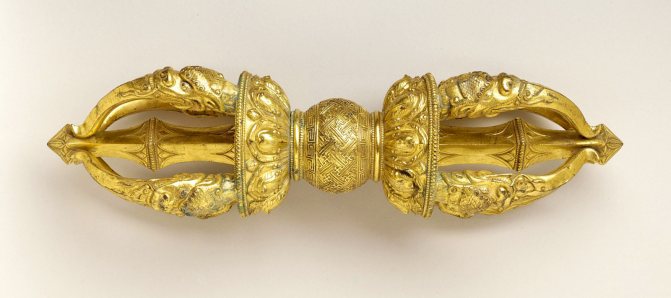

And released like Indra's thunder arrow - by Indra himself, it, distinguished by high strength, as if filling the whole earth with a loud roar, sparkling with a strong luster and terrifying, threw into awe...
"Mahabharata, book VII "Dronaparva," chapter 103
Literally, it can be translated from Sanskrit as 'the diamond stick. The diamond, which has the qualities of durability, represents the firmness of the spirit, an indestructible being. Lightning also symbolically implies insurmountable power. The Vajra was made by Twashtar, the blacksmith god, creator of the weapons of the gods. He also forged for Indra the spear of Amogha (translated from Sanskrit as 'unstoppable'). By Vajra, Indra breaks the mountain, the stone cave, and frees the waters (cows). It is also called Bhaudhara, Shata-bradhna ('about a hundred points'), Sahasra-parna ('the thousand-leafed'). According to the hymns of the Rigveda, Indra uses a bow, from which he releases an arrow with a hundred tips and a thousand feathers ("Rigveda", VIII.77. 6-7).
Sketches Tattoo of an Arrow
An arrow or several arrows can be depicted schematically, as a symbol. Such a tattoo will carry meaning, but will not perform an aesthetic function. But a large picture of an arrow or a whole bunch, such as made in watercolor style will serve as more and bright decoration.
